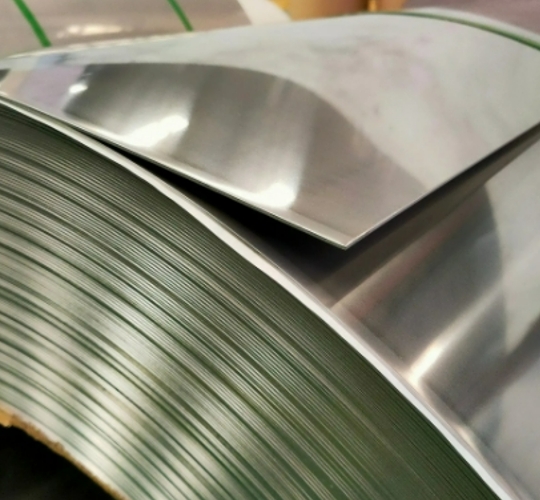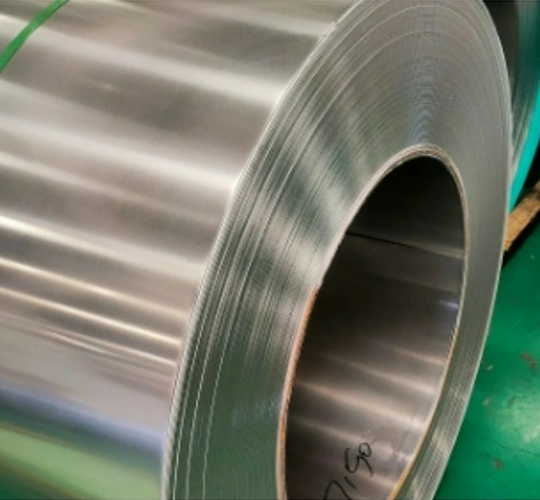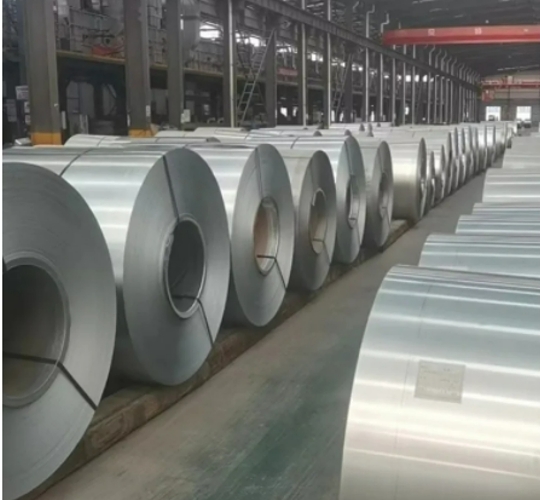Austenitic stainless steel coils are designed with ultra-low carbon chromium-nickel-molybdenum alloy (such as 304/316L), and the carbon content is ensured to be ≤0.03% through the argon-oxygen decarburization (AOD) refining process. They also feature excellent corrosion resistance, non-magnetism and formability. The product complies with the ASTM A240 standard and is suitable for harsh environments such as food processing and chemical equipment.
Galvalume Steel broke through with innovative alloy coating technology. The 55% aluminum-45% zinc alloy coating formed through the hot-dip galvanizing process is metallurgically combined to construct a dual defense system that combines physical barrier and electrochemical protection. Its corrosion resistance is four times that of ordinary galvanized steel. It can stably serve in a salt spray environment for over 1,500 hours. Even when subjected to a 90° extreme bending, the coating remains intact. With its outstanding formability and coating compatibility, this material is widely used in the bracket system of the photovoltaic industry, which can increase the weather resistance of the equipment by 30%. In the field of home appliance manufacturing, it provides long-lasting protection and an attractive appearance for products such as ovens and washing machines; In the application of building roofs, it effectively resists the erosion of industrial atmosphere and has a service life of more than 25 years.
Galvanized Steel, a cornerstone material in industrial protection, forms a dense zinc layer on the surface of steel through hot-dip or electroplating processes. By precisely controlling the coating thickness of 80-600g /㎡, a long-lasting anti-corrosion period ranging from 5 to 50 years can be provided. With a cost advantage of only one-third that of stainless steel, it can meet the demands of 80% of conventional anti-corrosion scenarios, thus occupying an important position in the market. From the steel structure frames of high-rise buildings to the guardrails and street lamp poles of urban infrastructure, and even to the chassis components of automobile manufacturing, galvanized steel plates are everywhere. When combined with Prepainted Steel color-coated sheets, a composite system of "anti-corrosion at the bottom layer + surface decoration" can be created, enabling outdoor facilities to have excellent protective performance while also featuring rich colors and an attractive appearance.
Aluminum Coil/Pipe/Plate leads the trend of material innovation with the perfect combination of lightweight and high performance. Based on high-end alloy systems such as 6061 and 7075, through advanced rolling and extrusion processes, a variety of product forms are formed. 0.01mm food-grade aluminum foil, with its excellent barrier performance, provides reliable moisture-proof and fresh-keeping protection for medicines and foods. The 1-3mm aluminum coil for construction, after being treated with fluorocarbon roller coating, not only meets the high standard of AAMA 2605, but also adorns the brilliant appearance of global landmark buildings such as the Burj Khalifa in Dubai with brilliant colors and long-lasting weather resistance. The internal threaded aluminum tubes in the aluminum tubes, by optimizing the heat exchange structure, increase the heat exchange efficiency of the air conditioning system by 20%. Aviation-grade seamless aluminum tubes, with their high strength and lightweight characteristics, can withstand high-pressure fuel transportation at 30MPa, providing crucial support for the aerospace industry. After the 5 series aluminum plates are formed through hot stamping, the vehicle body weight is reduced by 30% while the strength is increased by 40%, contributing to the breakthrough of lightweight in new energy vehicles. The 7-series aluminum plate, with its outstanding mechanical properties, has become the core material for key components such as the wing ribs of the C919 passenger aircraft.
Stainless Steel, with its precise alloy formula and outstanding performance, has become the preferred material under extreme conditions. Based on iron-based alloys with a chromium content of ≥10.5%, a diverse range of product series have been derived by precisely regulating the proportions of elements such as nickel, molybdenum and titanium. Type 304 stainless steel, with its classic composition of 18Cr-8Ni, has good versatility and food-grade safety, and is widely used in kitchenware, medical devices and other fields. 316L type stainless steel, due to the addition of 2.5% molybdenum and the adoption of a low-carbon design, has excellent resistance to chloride ion corrosion and can operate stably in harsh environments such as seawater desalination and pharmaceutical purified water systems. The 310S type stainless steel, with its high alloy content of 25Cr-20Ni, can maintain excellent oxidation resistance and mechanical properties in a high-temperature environment of 1200℃, making it an ideal choice for heat treatment furnace tubes and nuclear power steam pipes. In addition, stainless steel also performs exceptionally well in the field of precision processing. The wall thickness tolerance of seamless pipes can be controlled within ±0.05mm, and the thickness of ultra-thin steel strips can reach 0.05mm, which can meet the application requirements of all scenarios from deep cryogenic processing at -253 ℃ to high temperatures at 1150℃.
Aluzinc Steel is specifically designed for extreme environmental challenges. Its unique gradient alloy coating (with an aluminum content of 5-15%) effectively resists harsh conditions such as high salt spray, high acid and alkali, and high humidity through innovative processes. Strictly certified by the GB/T 14978 standard, in the construction of coastal wind power towers, its service life is 1.5 times longer than that of ordinary galvanized steel. It can effectively resist sulfide erosion in highly corrosive environments such as waste incineration plants. The dual protection mechanism of "aluminum-based physical barrier + zinc-based electrochemical protection" enables it to remain stable in acidic and alkaline environments with pH ranging from 3 to 11, providing reliable long-term protection for key facilities in fields such as chemical engineering and Marine engineering.
Prepainted Steel perfectly integrates the functionality and aesthetics of metallic materials through advanced coating technology. Its base coating covers a variety of types: The PE polyester coating offers over 100 standard color options and has a color retention performance of 10 years, making it the preferred choice for economical applications such as factory roofs and partition boards. The HDP high-weather-resistant coating, through optimizing the formula, reduces the ultraviolet absorption rate by 20%, achieving a long-term weather resistance of 15 years and is suitable for the exterior walls of commercial buildings. The PVDF fluorocarbon coating has even passed the highest standard certification of AAMA 2605 and can achieve an outstanding performance of zero powdering for 20 years in coastal landmark buildings. In addition to the basic performance, color-coated steel plates have also developed a rich variety of functional coatings: The antibacterial coating has been certified by ISO 22196, with a colony inhibition rate of up to 99.9%, providing guarantees for places with extremely high hygiene requirements such as hospitals and food processing workshops; The self-cleaning coating utilizes photocatalytic titanium dioxide technology to decompose surface contaminants and achieve self-cleaning by rainwater. The thermal conductivity of the thermal insulation composite coating is as low as ≤0.05W/(m · K), effectively contributing to the realization of the 75% energy-saving target for buildings and playing a significant role in emerging fields such as photovoltaic building integration.









